| |
|
|
| (Brisbane
und Frazer Island) |
| |
|
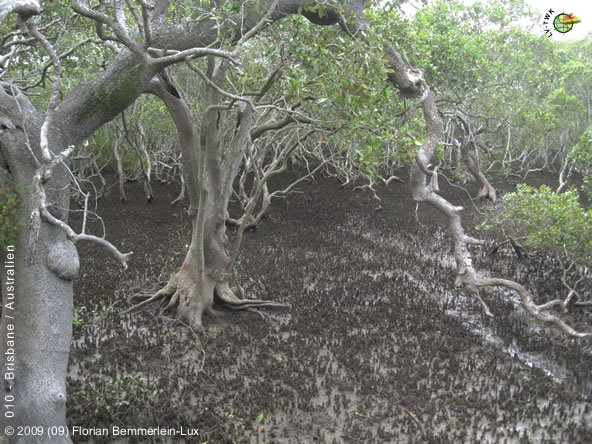
|
| |
|
 Abb.
F5-02/01:
Abb.
F5-02/01:
Avicennia
marina (Forssk.)
Vierh. (= Avicennia officinalis L.) - Graue
Mangrove - mit Atemwurzeln. Der Baum erreicht eine
Höhe bis 10m, selten 25m, ist verbreitet vom Indopazifik
bis Sinai / Ägypten sowie Südafrika, Australien
und Neuseeland. Aufn. Florian Bemmerlein-Lux im Sept. 2009
(bei Brisbane, Australien)
"Avicennia
marina, the pioneer of mangrove species, is possibly the most
widely distributed of all mangroves, ranging widely across
the Indo-West Pacific. Cold tolerant populations are further
recognised as genetic variants restricted to southern Australia
and New Zealand. Where these varieties overlap, they appear
to have no inhibition to genetic mixing. Zones of overlap
occur in three areas of Australia, including: Gulf St Vincent
in South Australia, Port Curtis to Moreton Bay in Queensland,
and Wyndham to Karratha in Western Australia. ..."
 (mangrovewatch.org)
[date
of access: 05.02.12] (mangrovewatch.org)
[date
of access: 05.02.12]
|
| |
| |
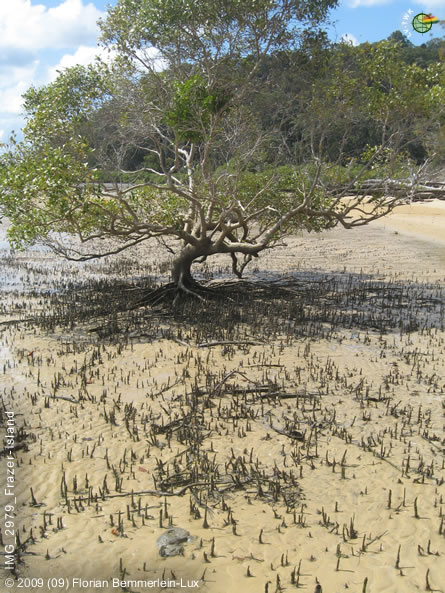 |
|
|
 Abb.
F5-02/02:
Abb.
F5-02/02:
Einzelexemplar von Avicennia marina (Forssk.)
Vierh. (= Avicennia officinalis L.) im unmittelbaren
Uferbereich eines stark degradierten Mangrove-Bestandes.
Deutlich
zu erkennen die spargelförmigen, negativ geotrop (nach
oben) wachsenden Pneumatophoren
(Atemwurzeln). Aufn. Florian Bemmerlein-Lux im Sept. 2009
(Frazer Island, Australien) |
| |
| |
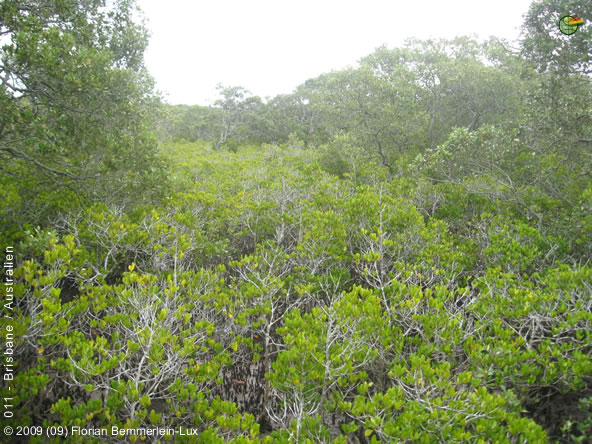 |
|
|
 Abb.
F5-02/03:
Abb.
F5-02/03:
Grosser geschlossener Bestand von Avicennia marina
(Forssk.) Vierh. (= Avicennia officinalis L.) - Graue
Mangrove - an der Küste bei Brisbane.
Aufn. Florian Bemmerlein-Lux im Sept. 2009 (Australien)
"In addition to its extraordinary wide tolerance of
temperature conditions, Avicennia marina further shows remarkable
adaptation to: 1) a wide range of tidal inundation levels
varying from 1-10 m; 2) a wide moisture tolerance from the
wettest to driest regions; 3) a wide tolerance of salinity
varying from freshwater to hypersaline; and 4) various substrate
types from reef flats, to sandy or rocky embayments and to
fine clay mudflats. These features provide this species with
significant dispersal advantages since it can become established
in sites where no other mangrove can survive. Avicennia marina
is distinguished from its closest relative in Australia, A.
integra, by its acute leaf apices, capitate inflorescences,
smaller flowers, mostly glabrous radicle and rounded fruit.
Three varieties are recognised in Australia."  (mangrovewatch.org)
[date
of access: 05.02.12] (mangrovewatch.org)
[date
of access: 05.02.12]
|
| |
| |
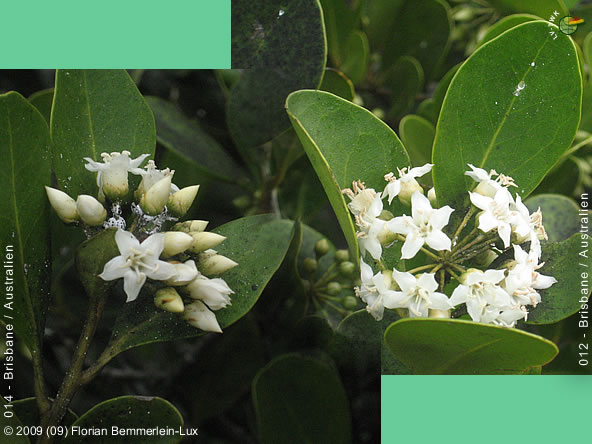 |
| |
 Abb.
F5-02/04:
Abb.
F5-02/04:
Blütenstand von Aegiceras corniculatum
(L.) Blanco - River mangrove bzw. Flussmangrove
-, verschiedentlich auch 'Schwarze Mangrove' genannt. Aufn.
Florian Bemmerlein-Lux im Sept. 2009 (bei Brisbane, Australien)
"Shrub or low tree growing to 6m tall, but in Singapore
it usually grows up to only 1-2m tall.Leaves (4-8cm) thick,
leathery dark green glossy above, paler below with prominent
reddish midrib below. The leaves are arranged in spirals.
Flowers white or pale pink and fragrant, appearing in a ball-like
cluster of 10-20. They are rich in nectar. According to Tomlinson,
from the structure of the flowers and the fact that these
produce nectar and a fragrance, the plant seems to be pollinated
by insects. But there are no records of flower visitors. The
fruits and seeds are well adapted to water dispersal.
Fruit long (5-8cm) cylindrical with pointed tip, usually curved.
They resemble long beans, tiny bananas or horns and are light
green to pink. 'Corniculatus' means 'with little horns' while
the Malay name 'Kachang' means 'bean'. Another Malay name
for it is 'Kuku Lang Laut' which means 'Claw of the Sea Eagle'.
Each fruit contains a single elongated seed which undergoes
cyptovivipary, i.e., it germinates while on the parent tree,
but does not emerge through the fruit wall until the propagule
falls off. Bark fissured with numerous lenticels. Roots running
along the soil surface."  (wildsingapore.com)
[date
of access: 05.02.12] (wildsingapore.com)
[date
of access: 05.02.12]
|
| |
| |
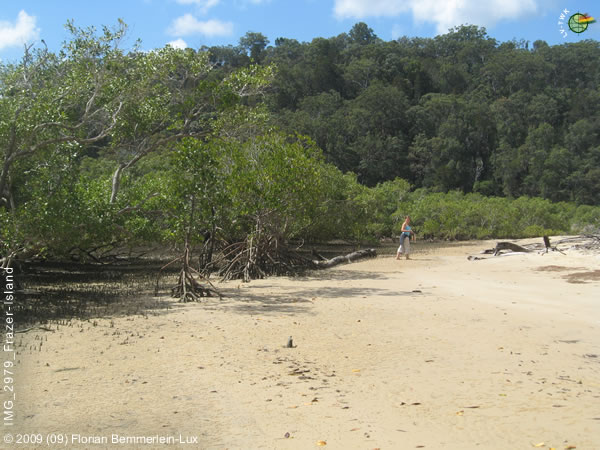 |
| |
 Abb.
F5-02/05:
Abb.
F5-02/05:
Rhizophora stylosa
Griff., (Bildmitte, Mangrove mit Stelzwurzeln) und Avicennia
marina (Forssk.) Vierh. links von Rh. stylosa.
Aufn. Florian Bemmerlein-Lux im Sept. 2009 (Frazer Island,
Australien).
"Rhizophora stylosa is the ubiquitous mangrove of
Australia’s northern coastline. The species is tolerant
of a wide range of exposure conditions allowing it to occupy
both muddy downstream estuarine reaches, plus sandy, rocky,
and coral reef rampart intertidal areas. It often forms monotypic
stands of either columnar tall trees, or as dense and impenetrable
thickets, depending on climate and sediment conditions. Rhizophora
stylosa is distinguished chiefly from R. mucronata by its
long slender style, and supported by: distinct bracts and
bracteoles instead of minute ones; 4-16(rarely 1 or 64)-flowered
inflorescences instead of 1-2(rarely 4)-flowered ones; regular
ovoid-elliptic closed flower buds instead of irregular obovoid
ones; and generally shorter propagules reaching 65 cm in length
instead of 80 cm.
Rhizophora stylosa is commonly associated with other downstream
estuarine species, Sonneratia alba, Avicennia marina and Camptostemon
schultzii. In areas of less freshwater influence, R. stylosa
can extend further upstream where it is associated with Ceriops
tagal and C. australis, plus Avicennia marina and occasionally
R. apiculata and R. X lamarckii."
 (mangrovewatch.org)
[date
of access: 05.02.12] Siehe auch (mangrovewatch.org)
[date
of access: 05.02.12] Siehe auch  "Verschiedene
Wurzel-Typen in den Immerfeuchten Tropen" "Verschiedene
Wurzel-Typen in den Immerfeuchten Tropen"
|
| |
| |
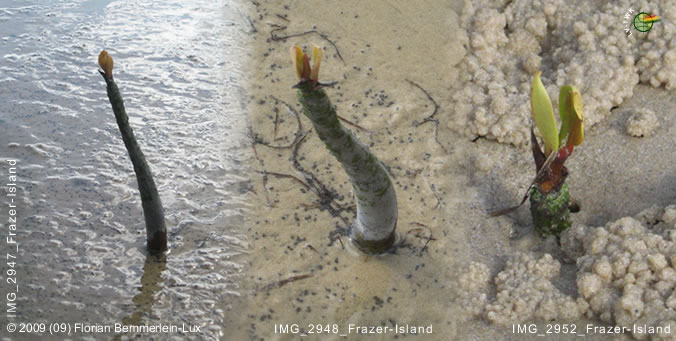 |
| |
 Abb.
F5-02/06:
Abb.
F5-02/06:
Jungpflanzen
von Rhizophora stylosa Griff. (Spotted
Mangrove), von links Bild 1 und 2. Die 3. Jungpflanze
ist unklar.
Aufnahmen Florian Bemmerlein-Lux im Sept. 2009 (Frazer Island,
Australien).
Zum Vergleich  Rhizophora
mangle (Rote Mangrove). Rhizophora
mangle (Rote Mangrove). |
| |
| Weitere
verwandte Themen:
|
|
|
| |
| |
| |
|
|
|